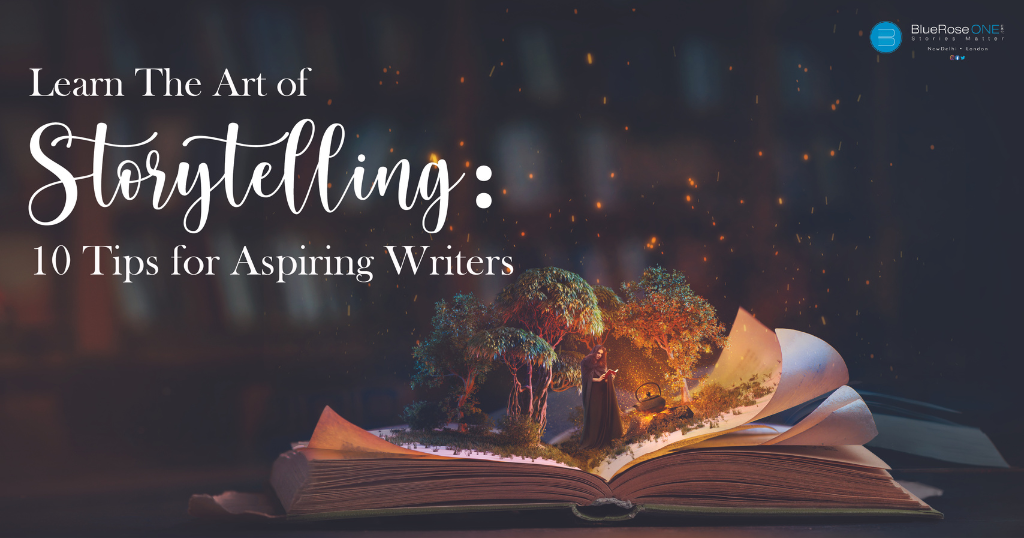Storytelling is an ancient and powerful craft that has been a fundamental part of human culture for millennia. From cave paintings to epic poems, oral traditions to novels, storytelling has evolved and adapted over the years, but its essence remains the same: to captivate, entertain, inform, and inspire.
Read: A Complete Guide on How to Make Your Book an International Bestseller
If you’re an aspiring writer looking to master the art of storytelling, you’ve come to the right place. In this digital age, where stories are told through various mediums, including books, films, podcasts, and social media, understanding the core principles of storytelling is more important than ever.
In this article, we’ll explore ten tips to help you become a better storyteller and provide examples to illustrate each point.
- Start with a Strong Hook
- Develop well-defined characters
- Show, don’t tell.
- Create conflict and tension.
- Build a Compelling Setting
- Use foreshadowing.
- Craft a Well-Defined Plot
- Develop themes and motifs.
- Use dialogue effectively.
- Edit and revise
- Start with a Strong Hook
Every great story commences with a hook, a captivating opening that seizes the reader’s or viewer’s attention and doesn’t let go. This could be an enigmatic question, a shocking statement, or a vivid scene that piques curiosity. The hook sets the tone for the entire narrative, enticing the audience to continue reading or watching.
In J.K. Rowling’s “Harry Potter and the Sorcerer’s Stone,” the novel opens with the line, “Mr. and Mrs. Dursley of number four, Privet Drive, were proud to say that they were perfectly normal; thank you very much.” This seemingly mundane introduction conceals the extraordinary world of magic that will soon unfold.
The importance of a strong hook cannot be overstated. It is your first opportunity to draw your audience into your story and captivate their interest. Without a compelling beginning, readers or viewers may never venture further into your narrative. - Develop well-defined characters
Characters are the lifeblood of any story. To create memorable and relatable characters, you must invest in their development by endowing them with depth, motivations, and flaws. Readers or viewers should be able to empathise with your characters’ struggles and journeys.
In J.R.R. Tolkien’s “The Lord of the Rings,” Frodo Baggins is a humble and unassuming hobbit who embarks on an epic quest to destroy the One Ring. His internal conflicts, fears, and growth as a character make him compelling and relatable.
Your characters should feel real, with their own unique qualities and backgrounds. This makes it easier for your audience to connect with you on a personal level. When readers or viewers care about the characters, they become emotionally invested in the story. - Show, don’t tell.
A cardinal rule of storytelling is “show, don’t tell.” Instead of explicitly stating information, use vivid descriptions, actions, and dialogue to reveal details. This technique immerses the audience in the story and allows them to draw their own conclusions.
In Harper Lee’s “To Kill a Mockingbird,” the author doesn’t tell the reader that Atticus Finch is a moral and upstanding lawyer. Instead, his actions and interactions with others demonstrate his character and values.
When you show instead of tell, you let your audience experience the story for themselves. This engages their imagination and creates a more immersive reading or viewing experience. - Create conflict and tension.
Conflict is the driving force of a story. It provides the motivation for the narrative to progress and evolve. Introduce obstacles, challenges, and opposing forces that keep the audience engaged and eager to see how the conflicts are resolved.
In George Orwell’s “1984,” the protagonist Winston Smith faces intense conflict as he rebels against the oppressive regime of Big Brother. The tension builds as he navigates a world where conformity is enforced and independent thought is a crime.
Conflict can take many forms, including external clashes, internal struggles, and even moral dilemmas. It keeps the story dynamic and ensures that the audience remains invested in the outcome. - Build a Compelling Setting
The setting of your story provides the backdrop for the characters and events. Whether it’s a real-world location or a fantastical realm, a well-crafted setting can enhance the atmosphere and immerse the audience in the narrative.
In Arthur Conan Doyle’s “Sherlock Holmes” stories, Victorian-era London becomes a character in itself, with its fog-shrouded streets, gaslit alleys, and hansom cabs. This setting adds depth and authenticity to the mysteries Holmes unravels.
A compelling setting should not be overlooked. It can greatly influence the mood of your story and can even become a character in its own right. When well constructed, the setting enriches the reader’s or viewer’s experience and helps them become fully immersed in the narrative. - Use foreshadowing.
Foreshadowing is a storytelling technique where you hint at future events, creating anticipation and intrigue. It can be a powerful tool to keep your audience engaged and guessing.
In William Faulkner’s “A Rose for Emily,” the author drops subtle hints throughout the story about the mysterious events surrounding the character Emily Grierson. This foreshadowing builds suspense and adds to the story’s eerie atmosphere.
Foreshadowing adds depth and complexity to your narrative. It teases the audience with hints of what’s to come, creating a sense of anticipation and excitement. When done effectively, it can lead to surprising and satisfying payoffs. - Craft a Well-Defined Plot
A well-structured plot is the backbone of a good story. It includes the introduction, rising action, climax, falling action, and resolution. Each part should be carefully crafted to maintain the audience’s interest and provide a satisfying conclusion.
In F. Scott Fitzgerald’s “The Great Gatsby,” the plot follows the life of Jay Gatsby and his unrequited love for Daisy Buchanan. The story’s climax, set against the backdrop of a lavish party, is a pivotal moment that changes the characters’ lives.
A well-structured plot keeps the narrative flowing smoothly. It ensures that there are compelling events and developments throughout the story, ultimately leading to a resolution that satisfies the audience. - Develop themes and motifs.
Themes and motifs are recurring ideas, symbols, or concepts that add depth and complexity to your story. They can convey deeper messages or provide a unifying thread throughout the narrative.
In George Orwell’s “Animal Farm,” the theme of power and corruption is central to the story. The motifs of the farm’s transformation, the pigs’ behaviour, and the commandments reinforce this theme.
Themes and motifs add layers to your story. They provide a framework for exploring complex ideas and can create a more profound impact on your audience. - Use dialogue effectively.
Dialogue is a powerful tool for character development, conveying information, and advancing the plot. It should be authentic and purposeful, revealing the characters’ personalities and motivations.
In J.D. Salinger’s “The Catcher in the Rye,” the teenage protagonist, Holden Caulfield, expresses his unique voice and perspective through his colloquial and informal dialogue, allowing readers to connect with his character.
Dialogue is a crucial element in bringing your characters to life. It provides an opportunity for them to express themselves, interact with others, and reveal their thoughts and emotions. Well-crafted dialogue can make your characters more relatable and engaging. - Edit and revise
The final tip for aspiring writers is the importance of editing and revising. Great stories are often the result of multiple drafts and revisions. Editing helps refine your storytelling, eliminate inconsistencies, and enhance the overall quality of your work.
Stephen King, one of the most prolific and successful authors of our time, is known for his extensive editing process. He often revises his work multiple times to create polished and engaging stories.
Editing and revising are the keys to transforming a rough draft into a polished masterpiece. It allows you to fine-tune your narrative, correct errors, and ensure that your story is as captivating as possible.
The art of storytelling is a skill that can be learned and perfected over time. Whether you’re writing a novel, creating a digital narrative, or using storytelling in marketing, these ten tips will serve as a solid foundation for your storytelling journey.
Remember that practice, persistence, and a willingness to learn from both successes and failures are keys to becoming a masterful storyteller. By honing your craft, you can captivate your audience, share your message, and leave a lasting impact through the art of storytelling. So, go ahead and embark on your storytelling adventure; your audience is waiting to be enchanted by your words.
















